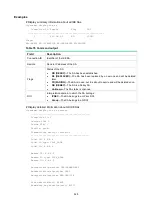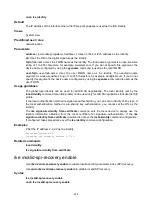
532
ike dpd
Use
ike dpd
to configure global IKE DPD.
Use
undo ike dpd
to disable global IKE DPD.
Syntax
ike dpd interval interval
[
retry
seconds
]
{
on-demand
|
periodic
}
undo ike dpd interval
Default
Global IKE DPD is disabled.
Views
System view
Predefined user roles
network-admin
Parameters
interval interval
: Specifies a DPD triggering interval in the range of 1 to 300 seconds.
retry seconds
: Specifies the DPD retry interval in the range of 1 to 60 seconds. The default is 5
seconds.
on-demand
: Triggers DPD on demand. The device triggers DPD if it has IPsec traffic to send and
has not received any IPsec packets from the peer for the specified interval.
periodic
: Triggers DPD at regular intervals. The device triggers DPD at the specified interval.
Usage guidelines
DPD is triggered periodically or on-demand. As a best practice, use the on-demand mode when the
device communicates with a large number of IKE peers. For an earlier detection of dead peers, use
the periodical triggering mode, which consumes more bandwidth and CPU.
When DPD settings are configured in both IKE profile view and system view, the DPD settings in IKE
profile view apply. If DPD is not configured in IKE profile view, the DPD settings in system view apply.
It is a good practice to set the triggering interval longer than the retry interval so that a DPD detection
does not occur during a DPD retry.
Examples
# Configure DPD to be triggered every 10 seconds and every 5 seconds between retries if the peer
does not respond.
<Sysname> system-view
[Sysname] ike dpd interval 10 retry 5 on-demand
Related commands
dpd
ike identity
Use
ike identity
to specify the global identity used by the local end during IKE negotiations.
Use
undo
ike identity
to restore the default.
Syntax
ike identity
{
address
{
ipv4-address
|
ipv6 ipv6-address
} |
dn
|
fqdn
[
fqdn-name
]
|
user-fqdn
[
user-fqdn-name
] }
Summary of Contents for FlexNetwork MSR Series
Page 1005: ...987 ...
















































